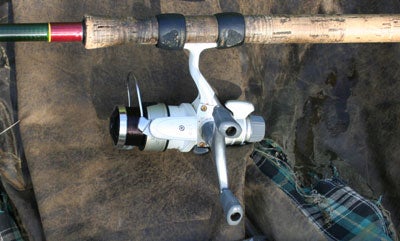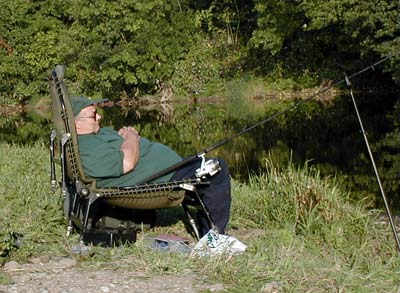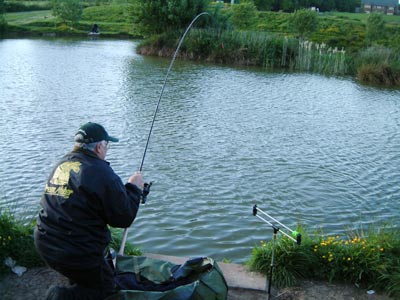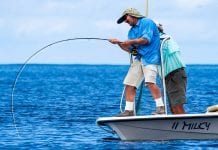| MARK WINTLE | |
|
(Beginner’s Essentials 6 – Getting Started 1)Beginner’s Essentials 6 – Getting Started 2Tackling UpIf you follow a certain procedure for tackling up whenever you go fishing you will find that eventually most of the things you have to do will be done automatically and seem like less of a chore. Also, following a set procedure makes it less likely you will miss something, perhaps something vital that can affect how well you fish. The following is a pretty standard procedure.Whenever possible tackle up away from the water’s edge. That way you won’t fall in as you move around putting your tackle together, nor will you scare the fish with your movements. If you intend using groundbait, mix this first and leave it to soak while you tackle up. Assemble your landing net and place this, along with your rod rests, at the spot you intend to fish from. Screw the bank stick to the keepnet (if you wish to use one) and place this in the water, staking it out if necessary.
If you’re fishing a spot you have fished before and know a little about what feed the fish require, now is the time to introduce a little loose feed and/or groundbait to give the fish a chance to come onto it while you carry on assembling your tackle. Now piece your rod together, making sure all the rings are in line, and fit any quivertip you may be using to the rod tip. Fit the reel to the rod about 4ins below the top of the butt or with the fixed screw fitting, making sure the spool is in perfect line with the butt ring. Open the bale arm and feed the line through all the rod rings, and quivertip rings, if you’re using one. If you miss one, go back and thread the line through it. If you don’t you’ll find it more difficult to cast, especially when the line is wet and clings to the rod. Next, assemble the end tackle, float or leger, to the main line, hook the hook around the leg of the butt ring (unless the rod has a special hook-retaining ring) and take the rod to your fishing position, placing it on one of your rod rests. Take your seat, or seatbox, to the fishing position and place it so that it sits firmly, packing where necessary underneath with soil or stones. Now sit on the seat and position the rod rest so that it is exactly right to give you a comfortable posture for placing and reaching the rod from it. Open the seatbox, or rucksack, and take everything out that you will be using as you fish. Place bait boxes, groundbait bowl, and catapult at your left side (if you’re right handed) within easy reach. Place your tackle box on your right, take out the disgorger, and slip this into your top pocket or somewhere equally handy – many anglers slip it behind their ear like a pencil, or hang it around their neck with a piece of string. Position other items, such as flask, sandwiches, etc, anywhere within easy reach, and place your landing net at your left side so that you can easily slide it forward to net a fish. Hang your hand towel over your knee and, finally, lay your rod holdall flat behind you.
You should now be a finely tuned fishing machine, set up, and ready to do business! But seriously, if you pay attention to detail, similar to the above, it can become a habit, and prevent you from slipping into sloppy ways in future. CastingCasting is all about timing; releasing the line at exactly the right moment, and is something that can’t be taught through a book. However, what we can teach you are the basic actions, and from there it is a question of practice. Casting is soon learned if you go about it the right way.Apart from long range casting, which needn’t concern you at this stage, it is almost always a good idea to cast from a sitting position. The following descriptions are for a right handed angler; left-handers should read left for right and vice-versa. The right hand should grasp the rod butt around the reel seat, so that the stem of the reel lies between the second and third finger. The left hand should grasp the rod at the base of the butt. With the rod in an almost upright position, with the end tackle hanging about 4ft below the rod tip, the index finger of the right hand should pick up the line where it leaves the bale arm of the reel. Now open the bale arm. Propel the tackle forwards and slightly upwards with enough force to just overcast the target area, straightening the index finger to release the line just before the rod reaches a parallel position with the water. If the tackle does land past the target area it doesn’t matter, it is simple enough to retrieve it to the right spot. That’s not the only way of casting of course, there is side-casting and all manner of other styles, but those you will develop for yourself once you have mastered the basic overhead cast, which is fine for both float and leger tackle. Playing FishIt is a common fault with beginners to play fish with the reel rather than the rod. They hold the rod straight up and simply wind like mad, usually getting nowhere due to the drag mechanism screaming in protest!Make no mistake, rods are for playing fish, reels are only for casting and recovering line. The first action is to make sure you set the drag correctly, which is set to release line before, and only just before, the breaking point of the line is reached. This is more difficult than it sounds, for changes in atmospheric temperature affect the efficiency of the clutch, meaning a setting at the beginning of a session can change during the course of that session. When heavy lines are being used, more than 6lb say, the change isn’t great enough to have much effect, but when 2lb lines are in use it can easily cause fish losses. Anyhow, drag mechanisms are not good enough for light lines even if changes in temperature didn’t cause changes to the setting.
The answer is to learn how to back-wind, which means that when the fish is pulling hard enough to break the line, you allow the reel handle to revolve backwards, under control, as it swims away. So why do we recommend that you set the clutch? Why bother? Because it can sometimes save the day if you make a mistake when back-winding. It does no harm to have a back-up, and the drag mechanism is very reliable and better when using heavier lines anyhow. The correct way to play a fish is to let the rod do the work. Allow the fish to bend the rod, and always keep the rod bent, never allowing slack line to develop, which could lead to the hook falling out, especially barbless hooks. Pull the fish towards you with the rod, then wind the rod towards the fish. Then repeat, as often as it takes, giving line to the fish when you have to by backwinding, or off the clutch if using heavy line. Never apply unnecessary force to the fish, for all that does is force the fish to fight back twice as hard. When playing a big fish on light tackle it is possible to coax the fish to the net, gently persuading it to swim in the direction you want it to, always allowing the rod to take the strain and to apply constant pressure, albeit it sometimes gentle pressure, on the fish. Confidence, really, is the key, as it is to so many angling applications. Next Week: Float fishing basics |
















